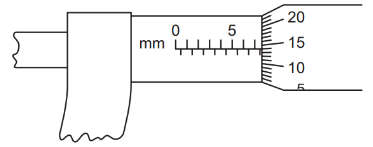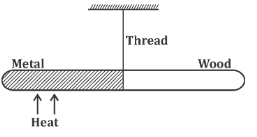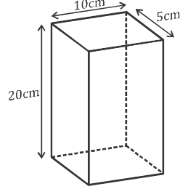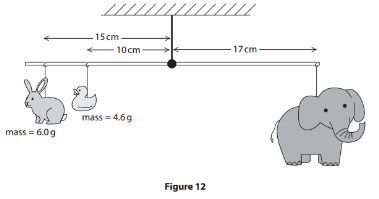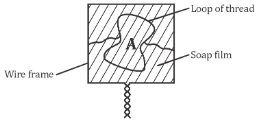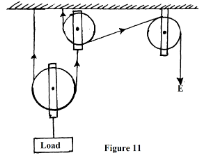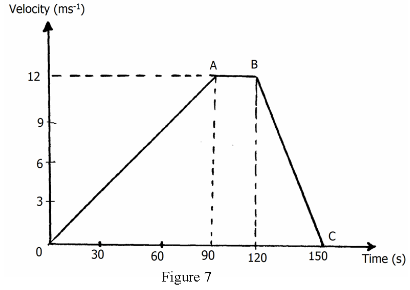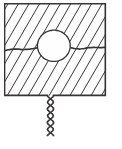INSTRUCTIONS TO CANDIDATES
- This paper consists of TWO sections: A and B.
- Answer ALL the questions in sections A and B in the spaces provided.
- ALL working MUST be clearly shown.
- Non-programmable silent electronic calculators and KNEC mathematical tables may be used.
SECTION A (25 MARKS)
- The diagram below sshows a section of a micrometer screw gauge . Give the reading shown (2mks)
- In an experiment to determine the density of liquid X, a student obtained the following date:
- Mass an empty density bottle = 55.0g.
- Mass of the density bottle + water = 80.0g.
- Mass of the density bottle + liquid x = 70g.
Determine the density of liquid x (density of water is 1000kg/m3) (3mks)
-
- State the Pascals principle. (1mk)
- If the cross-sectional area of the output piston in a hydraulic device is ten times that of the imput pistons area, by how much will the device multiply the input force? (1mk)
- Two beakers contains equal volumes of water and ethanol. A crystal of potassium permanganate is placed in the liquids at the bottom of each of the beakers. In which beaker will the diffusion be faster given that the two liquids are at the same temperature? Explain. (2mks)
- The figure 4.0 shows a rod made of wood on one end and metal on the other end suspended freely with a piece of thread so that it is in equilibrium.
The side made of metal is heated with a bunsen burner flame. State with a reason, the side to which the rod is likely to tilt.
(2 marks) - Clouds consist of very small drop of water. Explain why although water is much denser than air clouds do not seem to fall. (1mk)
- Dams which hold water reservoirs are thick at the base than at the top.
Explain (1mark) - Figure 3.0 shows a brick of mass 8.0kg standing upright on the ground as shown.
What is the pressure it exerts on the ground ? (g = 10Nkg-1) (3 marks) - The Figure below shoes three toiy animals hanging from a rod . The rod hangs from the ceiling by a string tied at the centre of the rod. The system is in equilibrium
Using principle of moments calaculate the weight of oy elephant (3mks) - Figure below shows a loop of cotton thread tied onto a wire frame. The figure is dipped into a soap solution and withdrawn.
Illustrate the shape of the loop of thread when part A is broken by touching it with a hot needle. (1 marks) - The diagram in fig 5.0 shows a section of a pipe with different cross-sectional area.
If water flows with a velocity of 10m/s in section A, what would be the velocity of water in section B ? (2marks) - The figure below shows a U – tube containing two liquids L1 and L2 of densities 0.5g/cm3 and 0.8g/cm3 respectively floating on a water surface. If the system is in equilibrium, determine the ratio h1: h2 (3mks)
SECTION B(55 marks)
-
- Define the term mechanical advantage of a machine. (1mk)
- Figure 11 shows a pulley system being used to raise a load.
This pulley system has an efficiency of 75%.- Determine the velocity ratio of the system. (1mk)
- Calculate the mechanical advantage of the pulley system. (2mks)
- What effort is required to raise a load of 240kg? (2mks)
- Calculate the work done by a person using this machine in raising a load of 120kg through a vertical distance of 2.5m (3mks)
- Give two reasons to explain why the efficiency of a machine cannot be 100%. (2mks)
-
- A boy throws a tennis ball vertically upwards from a truck moving at a constant velocity. Give the reason why the ball lands back exactly the same point where it was projected. (1 mark)
- Define impulse in terms of momentum. (1 mark)
- A trailer of mass 30 tonnes travelling at a velocity of 72km/h rams onto a stationary bus of mass 10 tonnes. The impact takes 0.5 seconds before the two vehicles move off together at a constant velocity for 15 seconds. Determine:
- the common velocity (3 marks)
- The distance moved after the impact (2 marks)
- the impulsive force on the trailer on impact (3 marks)
- Give reasons why a safety seat belt used in a vehicle:
- Should have a wide surface area (1 mark)
- Should be slightly extensible (1 mark)
-
- A motor car tyre is inflated so that the pressure is2 x 105Nm-2 at a temperature of 17°C.
During a journey the tyre heats up to 47°C, what will be the new pressure? (Assume that the tyre does not expand) (3mks) - Table 1 shows the results from Boyles Law experiment
Pressure (atmosphere) 1 1.3 1.5 1.8 2.3 2.6 3.2 3.7 Length of air column, L (mm) 41 30 27.5 22 18 16 12.5 11.0 1/L x 10-2 (mm-1) - Complete the table by filling in the values of the last two rows (2mks)
- Plot a graph of pressure against 1/L on the grid provided (4mks)
- Estimate the pressure of the air column when the length of the air is zero(2mks)
- A motor car tyre is inflated so that the pressure is2 x 105Nm-2 at a temperature of 17°C.
- The Figure below shows a graph of velocity against time for a moving body
-
- Describe the motion between O and A (2mks)
- Determine the acceleration between A and B (2mks)
- A body moving initially at 50ms-1 decelerates uniformly at 2ms-2 until it comes to rest . What distance does it cover from the time it started to decelerate (3mks)
- The initial velocity of a body of mass 50kg is 10ms-1. A constant resultant force of 15N is then applied. How long will it take before the kinetic energy doubles (3mks)
-
-
- Explain why it is advisable to use a pressure cooker at high altitude. (2marks)
- Water of mass 3.0kg initially at 20°C is heated in an electric kettle rated 3.0kW. The water is heated until it boils at 100°C (take specific heat capacity of water = 4200Jkg-1k-1, heat capacity of the kettle = 450Jkg-1 and specific latent heat of vaporization of water = 2.3MJkg-1j.
Determine:- The heat absorbed by the water. (2 marks)
- The heat absorbed by the electric kettle. (2 marks)
- The time taken for the water to boil. (2marks)
- How much longer it will take to boil all the water. (3marks)
MARKING SCHEME
- 7.64mm
- Mass of water = 80 − 55
= 25g√
Vol of water = mass = 25 = 25cm3 = volume of the bottle
P 1
Mass of liquid x = 70 − 55
= 15g
Density of x = mass of x √
Vol of the density of the
= 15g = 0.6g/cm3√ or 600kg/m3√
25cm3 -
- Pressure applied to an enclosed fluid is transmitted undiminished to every point in the fluid and to the walls of the container.✔1
- F1 = F2 but A2 = 10A1
A1 A2
∴F1 = F2
A1 10A1 ✔1✔1
F2 = 10A1 = 10
A1 A1
- Diffusion will be faster in the beaker containing ethanol. This is because ethanol is less denser than water and diffusion is faster in a less dense medium.✔1✔1
- The wooden part tilts upward or the metallic part tilts downwards (any correct)
Reason
The metal part expands on heating becomes longer thus the c.o.g shifts to the left - Terminal velocity of water is very low✔1
- Pressure increases with depth √1 The walls are thicker to withstand the greater force due to the increased pressure √1 to have maximum pressure, it should lie on minimum area ie. 3x6 cm2 √1
- W = mg
= 8kg x 10N/kg
= 80N ü1
Area = 10 x 5 = 0.005m2
100 100
P = F = 80N
A 0.005m2 ü1
= 16000N/m2 = 16000Pa ü1 - Total Clockwise moments = total anticlockwise moments✔1
17 x y = 6(15) + 4.6 (10)
17y = 90 + 46
17y = 136
Y =8kg
Hence weight = 80N -
- A1V1 = A2V2
48 x 10-4 x 10 = 12 x 10-4 V2 ü1
V2 = 48 x 10
12
= 40m/s ü1 - h1p1g = h2p2g ✓
h1 : h2 = p2 : p1✓
0.8 : 0.5 = 8 : 5✓
SECTION B(55 marks)
-
- Mechanical advantage is defined as the ration of load to effort✔1
-
- V.R = 4 ✔1
- Efficiency = M.A
V.R
M.A = V.R x efficiency✔1
= 4 x 75/100
= 3✔1 - M.A = Load
Effort ✔1
Effort = Load = 2400 = 800N✔1
M.A 3 - Efficiency = work output
Work input ✔1
Work imput = work output = 1200 x 2.5 ✔1
Efficiency 0.75
= 4000J✔1
-
- Some energy is lost due to the frictional force between the parts of the machine.✔1
- Some energy is used in lifting the parts of the machine✔1
-
- The ball has the same horizontal velocity as the truck
- Impulse is equal to change in momentum
-
- m1u1 + m2u2 = v(m1 + m2)Vü1
30,000 x 20 + 0 = V(30,000 + 10,000)
V = 600,000 ü1
40,000
V = 15m/s ü1 - S = Vt
= 15 x 15
= 225m ü1 - Ft = m(v - u)
t
= 30,000 (20 − 15)
0.5
- m1u1 + m2u2 = v(m1 + m2)Vü1
-
- So that they reduce the pressure exerted on a person's body.
- To reduce the momentum in more time to reduce the force and it does not cause an injury to the person.
-
-
P1 = P2 ✔1
T1 T2
P2 = P1 × T2
T1
= 2 × 105 × (47 + 273) ✔1
17 + 273
= 1.49 x 106 Pa ✔1 -
-
(1 – 4) ✔1mk (4 – 8) ✔1mkPressure (atmosphere) 1 1.3 1.5 1.8 2.3 2.6 3.2 3.7 Length of air column, L (mm) 41 30 27.5 22 18 16 12.5 11.0 1/L x 10-2 (mm-1) 2.44 3.33 3.64 4.55 5.56 6.25 8.00 9.09 -
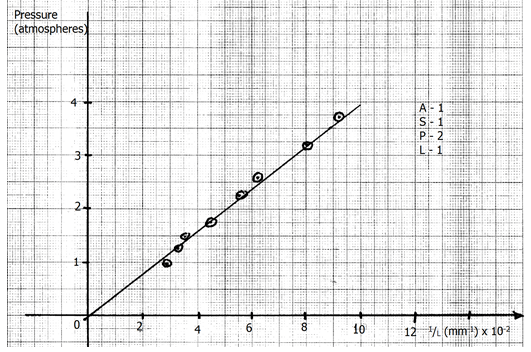
-
-
-
-
- OA – Increasing velocity or acceleration ✔1
- AB – Constant velocity✔1
- a = v − u
t
= 0 − 12
3.0
= − 0.4ms−2
v = u + at
0 = 50 – 2t
t = 50/2
t = 25s✔1
s = ut + ½at2
= 50 × 25 − ½ × 2 × 25 × 25 ✔1
= 1250 − 625
s = 625m✔1
OR
v2 = u2 – 2as✓1
2as = u2 – v2
s = u2 − v2
2×2
= 50 × 50 − 0 ✔1
2 × 2
= 2500
4
s = 625m - Initial ke = ½mv2
= ½ x 50 x 10 x 10
= 2500J
Double ke = 2500 x 2
= 5000J✔1
5000 = ½mv2 (v = final velocity)
V2 = 10000
50
V = √200 ✔1
V = 14.142ms−1
F = ma
15 = 50a
a = 15/50 ✔1
= 0.3ms−2
v = u + at
14.142 = 10 + 0.3t
t = 14.142 − 10
0.3
t = 13.8068s ✔1
-
-
- At high altitude atmospheric pressure is low, so boiling point is low. A pressure cooker increases pressure inside it which raises the boiling point hence faster cooking
-
- Heat absorbed by water = MCDq
= 3 x 4200 (100-20)X
= 1,008,000J ü1 - Heat absorbed by kettle = CDq
= 450 x (100 - 20)
= 36000J - Time taken for water to boil
= Pt = mcDq + CDq
3000t = 1008000 + 36000
t = 1044000 ü1
3000
= 348s ü1 - Q = mLv
= 3 x 2.3 x 106J
= 6.9 x 106 Jü1
Q = Pt
6.9 x 106 = 3000 x t
t = 6.9 x 106 = 2300
3000
t2 − t1 = 2300 − 348
= 1952s
- Heat absorbed by water = MCDq
Download Physics Paper 1 Questions and Answers - Form 3 Mid Term 3 Exams 2023.
Tap Here to Download for 50/-
Get on WhatsApp for 50/-
Why download?
- ✔ To read offline at any time.
- ✔ To Print at your convenience
- ✔ Share Easily with Friends / Students

